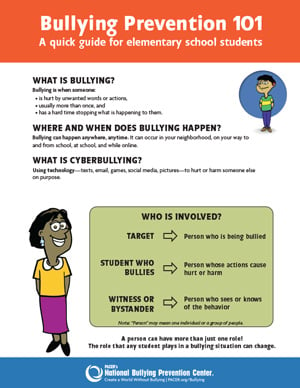In This Section
What is Bullying?
Bullying is when someone:
- is hurt by unwanted words or actions,
- usually more than once, and
- has a hard time stopping what is happening to them.
Where and When Does Bullying Happen?
Bullying can happen anywhere, anytime. It can occur in your neighborhood, on your way to and from school, at school, and while online.
What is Cyberbullying?
Cyberbullying is using technology, such as email, texts, social media, online gaming, or pictures to hurt or harm someone else with unwanted, aggressive, and repeated behavior.
Who is Involved?
| Target | Person who is being bullied |
| Student who bullies | Person whose actions cause hurt or harm |
| Witness or bystander | Person who sees or knows of the behavior |
Note: “Person” may mean one individual or a group of people.
A person can have more than just one role!
The role that any student plays in a bullying situation can change.
Did You Know…
…there is not just one kind of person who bullies
It’s not about how someone looks; it’s about their actions.
…that a disagreement is different than bullying
A disagreement or argument is when both sides express their views. People don’t always agree, and can be in “conflict” when they respectfully share their opposing views without putting down the other person.
…that someone you thought was a friend could be bullying you
If a friend is treating you in a way that hurts you and you have asked that friend to stop but they still continue, that is not friendship. That behavior could be bullying.
…there is a big difference between telling and tattling
A lot of kids say that they don’t want to tell an adult about bullying because they don’t want to be called a tattle-tale. Telling is done to protect yourself or another student from getting hurt. Tattling is done to get someone in trouble.
…your school probably has a policy against bullying
Every state in the nation has a law that prevents bullying in schools. If you don’t know yours, ask an adult at your school about it.
What Can You Do If You Are Being Bullied?
If you are being bullied, the first thing you should know is that it’s not your fault.
Nope. Not one bit. No one deserves to be bullied… EVER! There’s a lot you can do:
- Know that you do not deserve what is happening
- Tell someone: a parent, teacher, or trusted adult
- Develop a plan, with the help of an adult, about how you can respond to the situation
- Decide—with the help of an adult—how other students might help
What Can You Do If You See Someone Being Bullied?
If you see someone being bullied:
- Speak Up! You should tell an adult. Telling is not tattling. It’s okay to tell an adult when you see bullying or are being bullied. In fact, it’s a really smart thing to do!
- Reach Out! Tell the kid who is being bullied that they don’t deserve to be treated that way. Nobody does.
- Be a Friend! Let others know that you don’t accept bullying at your school, and others will be more willing to speak up, too. Ask friends to join you in being a kid against bullying.

